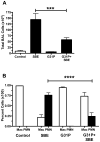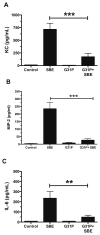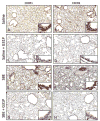CXCR1/CXCR2 antagonist CXCL8(3-74)K11R/G31P blocks lung inflammation in swine barn dust-instilled mice
- PMID: 25681618
- PMCID: PMC4396599
- DOI: 10.1016/j.pupt.2015.02.002
CXCR1/CXCR2 antagonist CXCL8(3-74)K11R/G31P blocks lung inflammation in swine barn dust-instilled mice
Abstract
Inhalation of agricultural occupational dusts from swine confinement facilities can result in lung inflammation. The innate immune response to organic barn dusts results in production of a number of pro-inflammatory factors in the lungs of barn workers such as cytokines, chemokines, and an influx of neutrophils. Many of these inflammatory factors are influenced by the chemokine CXCL8/IL-8 (KC or MIP-2 in mice). Previously, we have demonstrated that an endotoxin-independent component of swine barn dust extract (SBE) elevates lung chemokines in a protein kinase C (PKC)-dependent manner resulting in the significant formation of lung inflammatory cell infiltrates in a mouse model of SBE injury. In this study we test the ability of a CXCR1/CXCR2 antagonist, CXCL8(3-74)K11R/G31P (G31P) to block many of the features of lung-inflammation in response to challenge with SBE in an established mouse exposure system. Injection of G31P concurrent with SBE nasal instillation over a course of 3 weeks significantly reduced neutrophil accumulation in the lungs of barn dust exposed animals compared to those given SBE alone. There was a similar reduction in pro-inflammatory cytokines and chemokines IL-6, KC, and MIP-2 in SBE plus G31P-treated mice. In addition to excreted products, the receptors ICAM-1, CXCR1, and CXCR2, which all were elevated with SBE exposure, were also decreased with G31P treatment. SBE activation of PKCα and PKCε was reduced as well with G31P treatment. Thus, G31P was found to be highly effective at reducing several features of lung inflammation in mice exposed to barn dust extracts.
Keywords: Chemokines; Cytokines; G31P; IL-8; Occupational dusts.
Copyright © 2015 Elsevier Ltd. All rights reserved.
Figures






Similar articles
-
The combined CXCR1/CXCR2 antagonist CXCL8(3-74)K11R/G31P blocks neutrophil infiltration, pyrexia, and pulmonary vascular pathology in endotoxemic animals.J Leukoc Biol. 2005 Dec;78(6):1265-72. doi: 10.1189/jlb.0805458. Epub 2005 Oct 4. J Leukoc Biol. 2005. PMID: 16204619
-
Amelioration of pathology by ELR-CXC chemokine antagonism in a swine model of airway endotoxin exposure.J Agromedicine. 2009;14(2):235-41. doi: 10.1080/10599240902845047. J Agromedicine. 2009. PMID: 19437283
-
CXCL8((3-73))K11R/G31P antagonizes ligand binding to the neutrophil CXCR1 and CXCR2 receptors and cellular responses to CXCL8/IL-8.Biochem Biophys Res Commun. 2002 May 10;293(3):939-44. doi: 10.1016/S0006-291X(02)00318-2. Biochem Biophys Res Commun. 2002. PMID: 12051749
-
CXCL8((3-73))K11R/G31P antagonizes the neutrophil chemoattractants present in pasteurellosis and mastitis lesions and abrogates neutrophil influx into intradermal endotoxin challenge sites in vivo.Vet Immunol Immunopathol. 2002 Nov;90(1-2):65-77. doi: 10.1016/s0165-2427(02)00223-4. Vet Immunol Immunopathol. 2002. PMID: 12406656 Clinical Trial.
-
Combined anti CXC receptors 1 and 2 therapy is a promising anti-inflammatory treatment for respiratory diseases by reducing neutrophil migration and activation.Pulm Pharmacol Ther. 2015 Oct;34:37-45. doi: 10.1016/j.pupt.2015.08.002. Epub 2015 Aug 10. Pulm Pharmacol Ther. 2015. PMID: 26271598 Review.
Cited by
-
Ladarixin, a dual CXCR1/2 inhibitor, attenuates experimental melanomas harboring different molecular defects by affecting malignant cells and tumor microenvironment.Oncotarget. 2017 Feb 28;8(9):14428-14442. doi: 10.18632/oncotarget.14803. Oncotarget. 2017. PMID: 28129639 Free PMC article.
-
Genetic Ablation of CXCR2 Protects against Cigarette Smoke-Induced Lung Inflammation and Injury.Front Pharmacol. 2016 Oct 25;7:391. doi: 10.3389/fphar.2016.00391. eCollection 2016. Front Pharmacol. 2016. PMID: 27826243 Free PMC article.
-
A narrative review of chemokine receptors CXCR1 and CXCR2 and their role in acute respiratory distress syndrome.Eur Respir Rev. 2024 Jul 24;33(173):230172. doi: 10.1183/16000617.0172-2023. Print 2024 Jul. Eur Respir Rev. 2024. PMID: 39048127 Free PMC article. Review.
-
Alveolar epithelial and vascular CXCR2 mediates transcytosis of CXCL1 in inflamed lungs.Nat Commun. 2025 May 24;16(1):4846. doi: 10.1038/s41467-025-60174-w. Nat Commun. 2025. PMID: 40413164 Free PMC article.
-
Kinome analyses of inflammatory responses to swine barn dust extract in human bronchial epithelial and monocyte cell lines.Innate Immun. 2018 Aug;24(6):366-381. doi: 10.1177/1753425918792070. Epub 2018 Aug 9. Innate Immun. 2018. PMID: 30092684 Free PMC article.
References
-
- Ahuja SK, Lee JC, Murphy PM. CXC Chemokines Bind to Unique Sets of Selectivity Determinants that can Function Independently and are Broadly Distributed on Multiple Domains of Human Interleukin-8 Receptor B: Determinants of High Affinity Binding and Receptor Activation are Distinct. Journal of Biological Chemistry. 1996;271(1):225–232. - PubMed
-
- Biffl WL, Moore EE, Moore FA, Barnett CC., Jr Interleukin-6 Delays Neutrophil Apoptosis Via a Mechanism Involving Platelet-Activating Factor. The Journal of Trauma. 1996;40(4):575–8. discussion 578–9. - PubMed
-
- Cormier Y, Duchaine C, Israel-Assayag E, Bedard G, Laviolette M, Dosman J. Effects of Repeated Swine Building Exposures on Normal Naive Subjects. European Respiratory Journal. 1997;10(7):1516–1522. - PubMed
Publication types
MeSH terms
Substances
Grants and funding
LinkOut - more resources
Full Text Sources
Other Literature Sources
Miscellaneous

